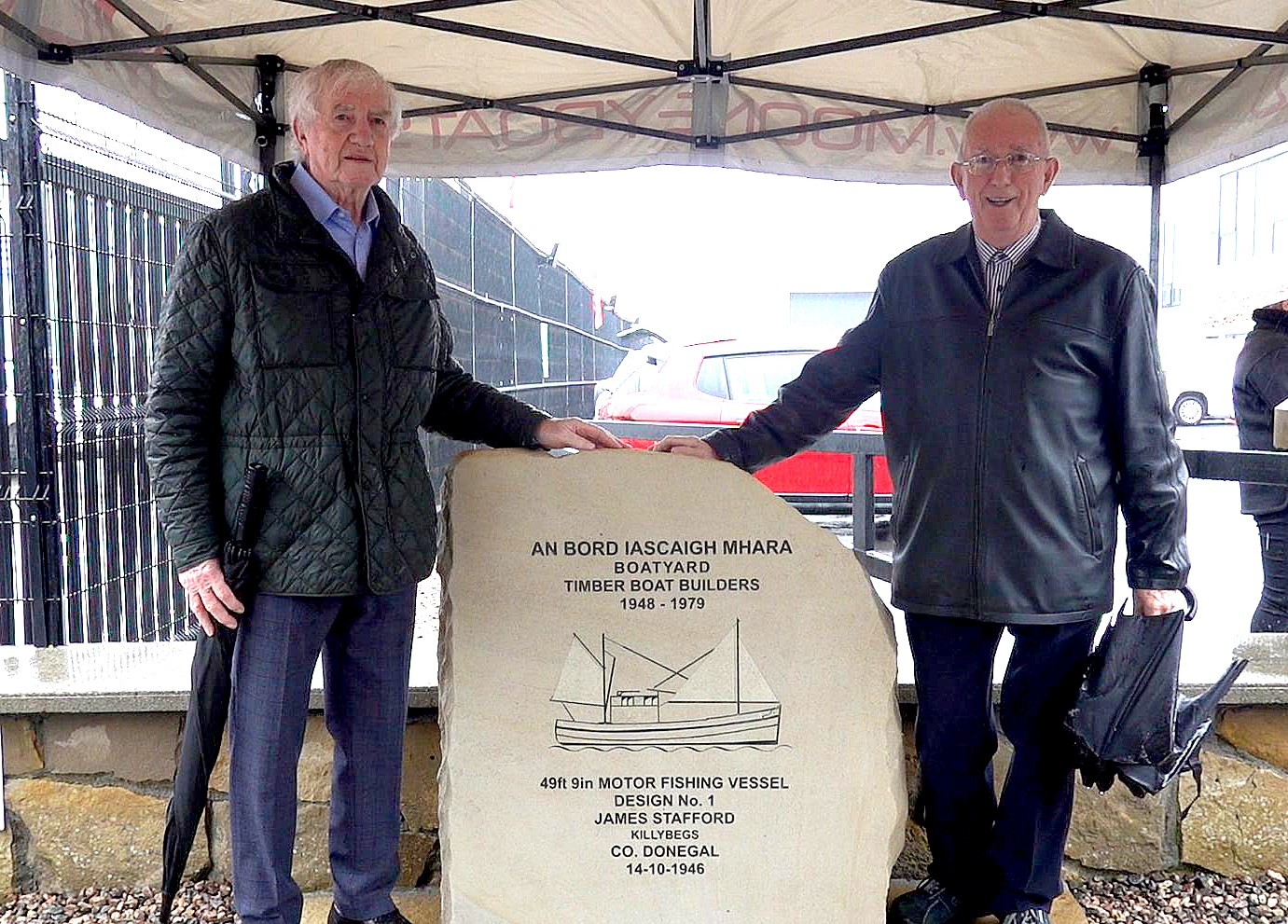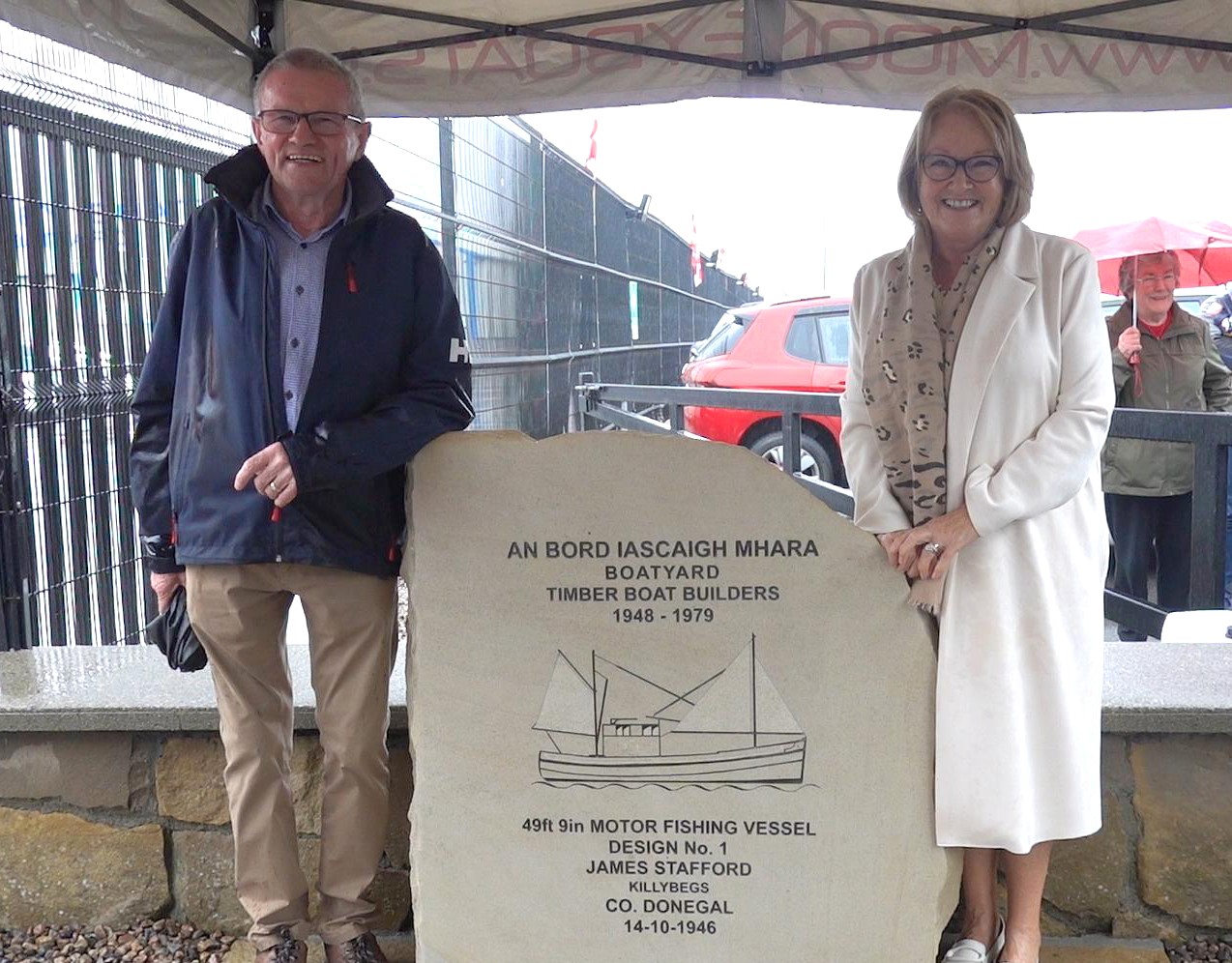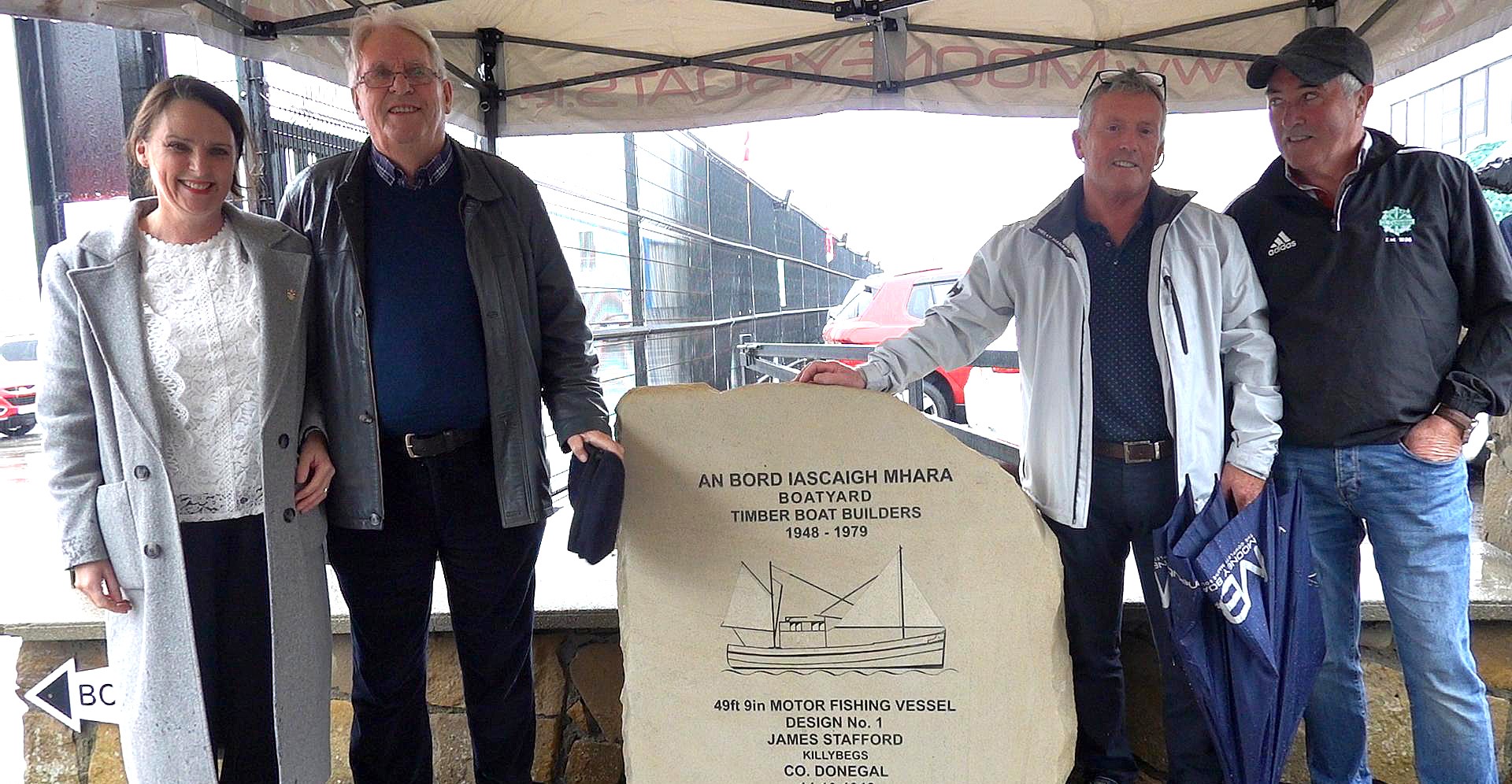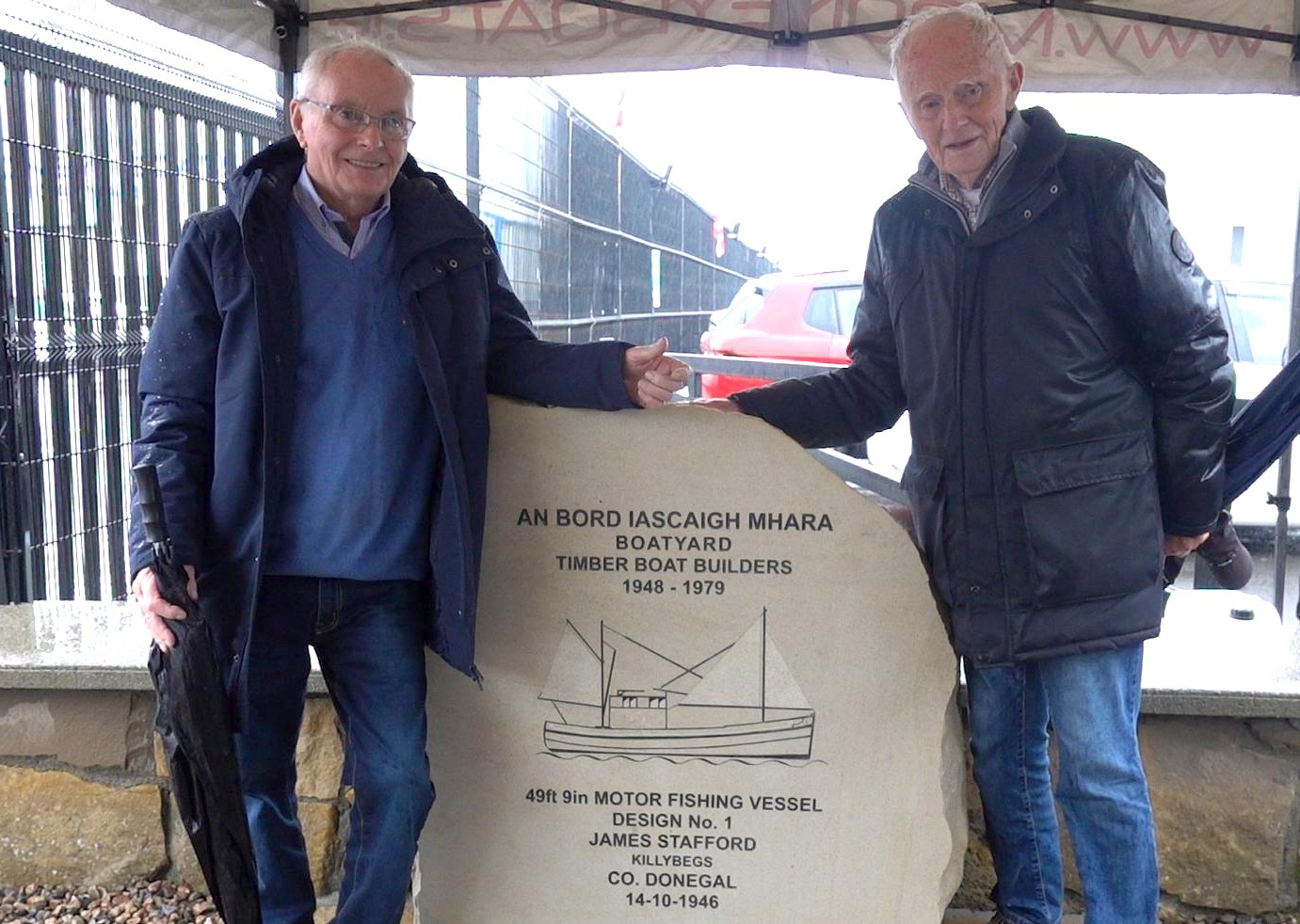
The organising committee pictured at the unveiling of the stone. L. to R. Joey Cunningham, Eugene Byrne, Lee Mooney, Michael O'Boyle
A ceremony took place in Killybegs to commemorate the old craft of wooden boatbuilding and to pay tribute to those who had carried on that trade.
An inscribed stone was erected and unveiled to honour the memory of those who worked in Killybegs Boatyard, while a minute’s silence was observed in memory of all the workers who had passed away down through the years.
Members of the public joined relatives and friends of past and present boatyard personnel for the unveiling ceremony.
Pat Conaghan, who had joined the Boatyard as an apprentice in the days of wooden boats, gave a short talk on the history of the boatyard from its inception.

“This ceremony is to raise a commemorative stone to mark the craft of wooden boatbuilding in Killybegs, and to remember the people who plied that trade,” he said. “It is appropriate to mark their contribution to their local community.”
The stone was designed and executed by Brian Kerrigan of the Drumkeelan quarries, Mountcharles. Inscribed on the stone is an outline of a 50-foot fishing boat, taken from one of the first drawings of Jim Stafford, who was the designer for the boatyard from the mid-1940s.
Stafford was an Arklow man and served as foreman in the boatyard for eight years.

The first Boatyard began as part of the Killybegs Industrial School, founded by the Bishop of Raphoe, Dr Patrick O’Donnell at the urging of Father Michael Martin, parish priest of Killybegs.
The boys of the School were taught farming, shoe-making, tailoring and boatbuilding. The Congested Districts Board (CDB) placed orders for boats with the School, and the first one was launched in 1899. Marine engines had not yet come on stream, so practically the only material required was timber.
This was sourced at first from Galway, and later from John Gardener who had a steam sawmill near Mountcharles. The boys, under an instructor, built about 40 vessels up to the First World War, when the effects of the war disrupted all aspects of life. Killybegs Harbour was a British port, serving as a submarine base, with two massive submarine support ships, the Platypus and the Vulcan, anchored there.

Two large motor boats were launched from the Yard towards the end of this period when engines first became available.
Following on from this, the upheavals during the period from 1919 into the early 1920s affected all business operations, and the Yard struggled for orders.
The CDB was gone by 1922, and the Killybegs Yard was left to fend for itself for the first time. The manager of the Yard was always a clergyman, whose main task was managing the Industrial School itself. Although well-intentioned, these men had no training in business matters and were ill-suited to running a commercial operation such as boat building.
Finally, our native government set up the Sea Fisheries Association (SFA), in 1930, and orders were placed with the boatyard for new boats. These were inshore craft up to 35 feet in length when a better effort might have been made to provide larger vessels.

The Second World War disrupted the industry as engines and other materials were very hard to get. The Yard came to a standstill and was purchased by the SFA. They began to turn out wooden boats 50 feet in length, which were designed by Jim Stafford, ARINA., already mentioned.
The first boat was launched in 1948, and the Yard turned out an uninterrupted run of increasingly large vessels up to 1980. During this time Bord Iascaigh Mhara (BIM), replaced the SFA and expanded the premises and workforce to meet the demands of the fishermen. Jim Stafford died in 1968, and Cyril Chisholm, BIM’s Naval Architect, modernised the existing boat plans and designed some of the largest wooden vessels to be built in the country. In the private sector, the Meevagh Boatyard had been re-opened, and begun turning out first-class wooden boats in the largest sizes. The general opinion among fishermen was that the boats from these two Donegal yards were untouchable in terms of design, quality and seaworthiness.
The last wooden boat, the 86ft Dermot Anne, was launched from Killybegs in 1980 for Danny Gallagher of Bruckless. Following on from this the Yard was leased to private firms who turned out a few fine steel vessels. Those companies did not stay the course, and the Yard closed, with a massive loss of employment. It was alleged that a significant amount of asset stripping was carried out at that time. The Donegal Democrat reported that the loss of those jobs was a ‘severe blow to the Killybegs Credit Union’. Following this, BIM sold the entire facility in 1984.

The late Micheal Mooney, who had started in the Yard as an apprentice over 20 years previously, was the purchaser. He began recruiting a workforce and turned the Yard into a successful commercial enterprise. Very sadly, he died at a relatively young age, but he had prepared his family to further modernise and expand the operation. It was to become the leading build and repair facility in the country.
THE CREDIT UNION
Killybegs Credit Union, which begun 56 years ago, had a very close relationship with the Boatyard. It was set up by BIM, and its foundations were laid by the Boatyard staff. It is interesting to see how it began.
In the summer of 1967 the local BIM agent, Michael Mitchell, decided the largest fishing port in Ireland would be well suited to a Credit Union. He met John Hume, who had started the Derry Credit Union, who advised him on the necessary procedures. Public meetings were held in Killybegs, and there was a strong attendance by Boatyard personnel. These included Des Houlihan, Pat Rowan, Josie Murrin, Pat Conaghan, and Michael Mitchell, the latter not actually on the staff of the Yard.
The first deposits were lodged by October, and Killybegs Credit Union was launched.
However, the weather-dependent and seasonal nature of the fishing in those years did not provide the steady wages required for regular savings. And so the Boatyard with its weekly wage packets, kept the Credit Union afloat in its early years. New factories such as Bridport-Gundry and Fimarex were established at this time, and they also helped.
The office staff of the Yard played a vital role by encouraging the employees to join the C.U. and agree to deductions from their pay as weekly deposits. But for the persistence of Boatyard staff and Credit Union founding members Mary Lafferty, Pat Rowan, Des Houlihan, and Josie Murrin, it is doubtful if Killybegs Credit Union would have weathered the first years of its existence. Sean McGuinness of Killybegs Seafoods, also one of the founding members, was the first treasurer.
During the following years, the bond between the Boatyard and the CU was further strengthened by the continuous presence on the various CU committees of Boatyard staff, while the late Cathal Conaghan and Colm Cunningham held the office of chairmen.
“We extend our thanks to the Mooney family, the owners of the Boatyard, for their co-operation in bringing this project to completion,” the committee said. “Thanks also to Barry O’Hara, who liaised with the committee on behalf of the Yard owners, and to the Kerrigan brothers who provided us with such a handsome stone.
“This ceremony was all about the past, but the future lies in the hands of the young men and women driving this industry. In that respect, we wish Mooney Boats many years of success.
The commemorative stone was then unveiled by the committee members, Michael O’Boyle, Lee Mooney, Eugene Byrne, Pat Conaghan, Joey Cunningham, Patrick Gallagher, and Brian McGilloway.”
Subscribe or register today to discover more from DonegalLive.ie
Buy the e-paper of the Donegal Democrat, Donegal People's Press, Donegal Post and Inish Times here for instant access to Donegal's premier news titles.
Keep up with the latest news from Donegal with our daily newsletter featuring the most important stories of the day delivered to your inbox every evening at 5pm.